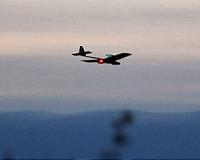| . |  |
. |
Monrovia CA (SPX) Aug 12, 2010 AeroVironment, Inc. (AV) announced that a full size wing developed as part of the Global Observer Joint Capability Technology Demonstration (JCTD) program has successfully completed a series of Wing Load Tests (WLT) in support of the Global Observer flight test program. The joint Department of Defense, NASA and AV team successfully performed the tests at the Flight Loads Laboratory located at NASA's Dryden Flight Research Center at Edwards Air Force Base (EAFB) in California. The team designed and built a specialized test fixture to apply loads to the modular, all-composite 175-foot Global Observer wing. The test validates the quality of AV's design, its analysis of flexible and lightweight structures and the resulting design tradeoffs made to maximize wing strength while minimizing weight - a critical balance in achieving reliable flight endurance. Global Observer is designed to be the first unmanned aircraft system (UAS) to provide robust, cost-effective and persistent communications and surveillance over any location, without latitude restrictions. The Global Observer JCTD program is sponsored by six U.S. government agencies that have provided more than $120 million in funding. "These successful tests confirm that the Global Observer wing, one of the most critical elements of the system, is prepared to handle the stress of high altitude, long endurance flight," said Tim Conver, AV's chairman and chief executive officer. "With ground and wing load testing behind us we look forward to demonstrating Global Observer's unique ability to fly longer and higher over any location than any other aircraft. That ability can translate into more valuable reconnaissance and communications at a lower cost to military and non-military customers." Wing loading refers to the dynamic stress that aircraft wings experience as a result of normal flight, turbulent air and aircraft maneuvers. The primary purpose of the WLT is to demonstrate the integrity of the Global Observer wing structure and acquire data that allow for validation of the design and comparison to actual flight test data. The structural integrity of the wing was tested by applying loads to the wing that approximate the maximum loads Global Observer is designed to withstand. Four simulated test sorties were performed on the wing with loads being applied in both positive (pulling up) and negative (pushing down) directions. The wing successfully passed all tests. Each aircraft in a Global Observer system is designed to fly at an altitude of between 55,000 and 65,000 feet for five to seven days. In addition to flying above weather and above other conventional airplanes, operation in this altitude range means that communications relay payloads on the aircraft could potentially be able to service a circular area on the surface of the earth up to 600 miles in diameter, equivalent to more than 280,000 square miles of coverage. Two Global Observer aircraft would alternate operation over any location on the globe every five to seven days to provide seamless coverage, making this the first solution to provide customers with practical, affordable coverage, wherever and whenever required. Communications relay and intelligence, surveillance and reconnaissance (ISR) payloads are being prepared for installation into the aircraft. Once development flight tests have been completed, payloads will be installed and joint operational utility flight demonstrations will be performed at EAFB. Global Observer is designed to address an urgent national security need for a persistent stratospheric platform and to offer a means to satisfy numerous high value civil and commercial applications. The system is intended to provide mission capabilities that include robust observation over areas with little or no existing coverage, persistent communications relay, the ability to relocate the system as required by theater commanders, dedicated communications support to other UAS and tactical on-station weather monitoring and data support.
Share This Article With Planet Earth
Related Links AeroVironment UAV News - Suppliers and Technology
 Azerbaijan To Buy Training Target Drones From Turkey
Azerbaijan To Buy Training Target Drones From TurkeyBaku, Azerbaijan (RIA Novosti) Aug 10, 2010 Azerbaijan will buy Turna unmanned aerial vehicles (UAVs) for training and target practice from Turkey, the Baku based ARA news agency has reported. "Negotiations on a deal are underway with Turkey," Turkish military sources were quoted as saying. They also said a group of Azerbaijani servicemen had been trained in Turkey in how to use, operate and service the aircraft. Turna a ... read more |
|
| The content herein, unless otherwise known to be public domain, are Copyright 1995-2010 - SpaceDaily. AFP and UPI Wire Stories are copyright Agence France-Presse and United Press International. ESA Portal Reports are copyright European Space Agency. All NASA sourced material is public domain. Additional copyrights may apply in whole or part to other bona fide parties. Advertising does not imply endorsement,agreement or approval of any opinions, statements or information provided by SpaceDaily on any Web page published or hosted by SpaceDaily. Privacy Statement |